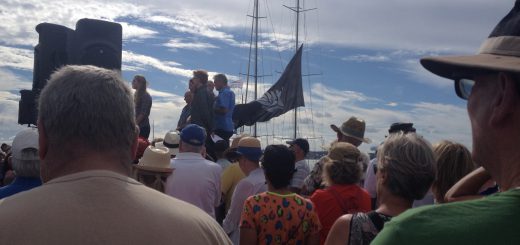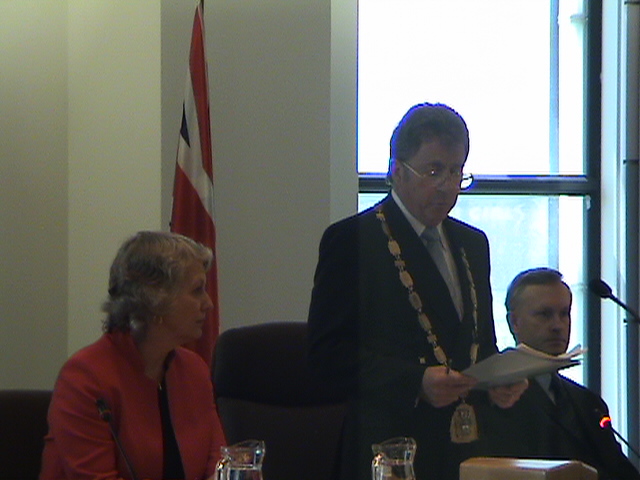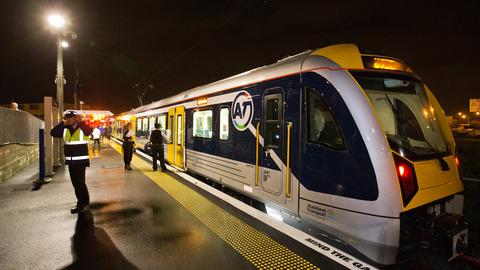Death of a soldier – my tribute to Ted Lees.
(Eulogy presented at St Mary’s Church, Holy Trinity Cathedral, Parnell, 18 November 2013).
I wish to thank Mrs Shirley Lees for asking me to speak here today. I am honoured to be given the opportunity to offer my tribute, just as I was honoured to be considered a friend – of a man of the calibre of Ted Lees.
I bring the condolences of the Mayor and members of the Auckland Council and heartfelt thanks for Ted Lees’ many years of service to Auckland and New Zealand.
When the American writer Stephen Ambrose referred to the young men and women who served in World War ll as ‘the greatest generation’, he could not have more aptly described Ted Lees as an embodiment of that generation. A generation which has sadly now – the menfolk at least – all but passed into history.
It could be said of New Zealand that its finest hour was in the great global struggle of World War ll. New Zealand’s performance during that conflict was out of all proportion to its size. During the War New Zealand had a higher proportion of its citizens in uniform than any Allied nation apart from the Soviet Union. During the exacting years of 1942-1944 New Zealand committed in terms of war expenditure, as a percentage of national income, more than any of the other Allies apart from the United Kingdom.
As with the New Zealand Infantry Division in the Great War, the First NZ Division of the Second World War, in which Ted Lees served from 1942 to 1945 came to be considered by friends and foe alike as an elite formation. Indeed the German commander of the Afrika Corps Field-Marshal Erwin Rommell considered the NZ Division, the best in the British 8th Army. It was hard-won accolades like these that led the British war historian John Keagan to write ‘New Zealanders whose settler independence with rifle and spade would win them a reputation as the best soldiers in the world during the 20th century.’
The quality of New Zealand’s armed services, the commitment and resourcefulness of its civilian soldiers, airmen and sailors was to bring New Zealand significant international prestige. Because of this New Zealand and its prime minister Frazer became highly respected by the Allied war leaders Winston Churchill and President Roosevelt. This hard-won prestige earned on the battlefield meant that New Zealand, punching well above its weight, would became a key player in the post war settlement – especially in the formation of the United Nations.
As we have heard Ted trained as a commando but Ted’s war contribution was not so much with rifle and spade but as a mechanical engineer with a flare for organisation. Mobility in World War ll was the difference between tactical success or failure – between life and death. Ted’s job was to ensure the tanks, armoured cars, bulldozers, trucks and jeeps in his care were maintained in the best possible condition – and when they were hit or immobilised to go out and rescue them, and if possible repair them and get them back into action.
He fought with the NZ Division in North Africa and Italy – all the way to Trieste.
Surviving being blown up by an enormous land mine Ted Lees came back from the war determined to live his life – to marry and raise a family and become a successful businessman in his chosen field of engineering. His vision was not just for himself. He saw his post-war career as extension of his service to his country – his contribution in the building of a modern post-war New Zealand. He had seen first-hand how with the proper preparation and motivation New Zealanders could compete with the very best during times of war – and he believed New Zealand could do it – had to do it – in times of peace.
Proper preparation meant having the best gear, the best equipment, the best machinery – and if New Zealand didn’t have it – then New Zealand should make it – he would make it. Ted set up his own company Lees Industries – repairing and manufacturing marine engines, agricultural equipment and equipment for airports
Indelibly influenced by his experience in that most successful of organisations, the NZ Division, Ted travelled the world as often as he could to search out the latest engineering innovations, to pick up the best ideas, to imitate, to improve and adapt for New Zealand conditions. He built up a loyal team of friends and colleagues – many of whom were returned servicemen like himself; and together they created a real technology hub. So much so that he and his colleagues didn’t just supply New Zealand but exported and supplied Australian factories, airports and port companies, including his setting up factories in Australia and Singapore.
Out of his love and experience of travel Ted also established a large inbound travel company to promote Tourism – and a network of travel agencies around New Zealand. He became the representative for the Asia Pacific region for the American Society of Travel Agents (Asta) and Pacific Asia Tourism Association (Pata).
Trade and travel also led to him being invited to become the Honorary Consul for Spain in New Zealand. He tackled this role with his usual enthusiasm, serving for nearly 30 years in the Consular Corps. His diligent efforts in building relations between Spain and New Zealand were rewarded with his being Knighted (Civil Merit) by the Spanish King Juan Carlos.
Ted Lees never accepted that being at the bottom of the world was a barrier for New Zealand in terms of trade and tourism. But what he had learned about infrastructure and logistics in the war made him determined to ensure that Auckland had the best possible seaport and airport supported with the best equipment.
Ted therefore made time to serve for many years as an elected member of the Auckland Harbour Board. The Auckland Harbour Board was close to his heart and while Ted actively pushed for continued technological and industrial improvements he always valued the wider responsibilities of the Harbour Boards – in terms of maritime planning, its harbourmaster role, its building of marinas, boat ramps and maintenance of moorings and its general support of marine-based recreation – as opposed to the more narrower, purely commercial focus of the port company which replaced the Harbour Board in the reforms of 1989.
Ted’s role in the Auckland Harbour Board chimed in well with his love for the Hauraki Gulf and his being a founding member of the former Hauraki Gulf Maritime Park Board. Like the Harbour Boards the Maritime Park Board was to be swept away in the reforms of the 1980s. As a coherent, focused, hands-on management agency for the Hauraki Gulf islands, the old Maritime Park Board has never been matched – and its historic contribution has yet to be fully appreciated. It was through our mutual interest in the Hauraki Gulf that I first met Ted in the early 90s. Ted and I were involved in an unsuccessful attempt to secure Pakatoa Island into public ownership – and then in an

Campaigning for Christine in the mayoralty race on 1998. Ted leads a combined operation putting up signs made up of both Lees and Lees (plural)
eventually successful attempt to acquire Kaikoura Island off Great Barrier.
Ted simply loved the Hauraki Gulf and he was passionate about giving New Zealanders access to it. His daughter Christine Fletcher recalls that during the grim winter fighting that went on around Monte Casino – Ted kept a vision of the Hauraki Gulf in his mind.
While Ted was a most canny and successful businessman it was never just about the money – there was always a bigger picture. That is where the inspiration for Lees Marine came from – Ted wanted Auckland families to have reliable engines for their launches and runabouts – so they could get out on the water and enjoy the Hauraki Gulf.
If I could I would like to share with you some other things Christine recalls about her dad.
“Dad was passionate about apprenticeships and employment. He treated staff well and always liked to include families. The annual staff family picnic was a huge affair with presents for everyone. He was exceptionally proud that there was never a strike in the history of the business, quite a feat when you think of the 1960’s and 70’s.
Growing up in the depression and his experience of war shaped Dad. He could never bring himself to throw anything away. He worked hard himself and expected that of everyone else. I know this well as I was made to work in the family business. Monday morning meetings with all the managers at 7.30AM were compulsory to get things started for the week! He was tough and frustrating at times. An ideas man, who led from the front, he was not so interested in detail. A handshake to him was all that was required to cement a deal. There had to be a trail of people behind him attending to the paperwork!
He was quite personally humble but knew to be successful for your community and business you had to get out and to sell the proposition.
He couldn’t have done any of this without Mum. They were the perfect team. Others will talk of this but I just want you to know how she was the cornerstone that allowed all of this activity to take place.”
Christine of course became a popular Member of Parliament and rose to be a cabinet minister and a Mayor of Auckland – achievements for which Ted was enormously proud – but Ted was just as proud of his other daughters Jan and Susie and their families.
In 2010, I was thoughtfully invited by Ted to join with his family and friends to the formal dinner which celebrated his well-deserved induction into the NZ Business Hall of Fame.
It was in August that I last saw Ted – he was clearly suffering and though he accepted the grim fact that he was dying – he didn’t agree with it – he wanted to live a bit longer, he had more things to do. But for all that he was still cheerful. He dealt with his illness courageously – just like the brave soldier he always was. We spoke of his time in the Division – about the fighting in Italy – and the last days of the war NZ Division racing northwards through Italy, liberating Florence and then all the way to Trieste. His recollections of those days were still vivid in his memory.
Which brings home to me that in saying farewell to Ted Lees we are saying more than farewell to one man – we are closing a chapter of our country’s history – and so farewelling a unique and great generation of New Zealanders that we will never see the like of again.
I offer the most sincere condolences to the Lees family, to Ted’s dear wife Shirley and his dearly loved girls Jan, Christine and Susie and the whole family.
Daniel Edward (Ted) Lees. 2 March 1923 – 11 November 2013
Eulogy delivered at the funeral held in St Mary’s Church at the Holy Trinity Cathedral, Parnell. 18 November 2013.






Dear Mike,
A wonderful and thoughtful eulogy marking the passing of a great New Zealander, thank you for your good words.
Regards
Mike